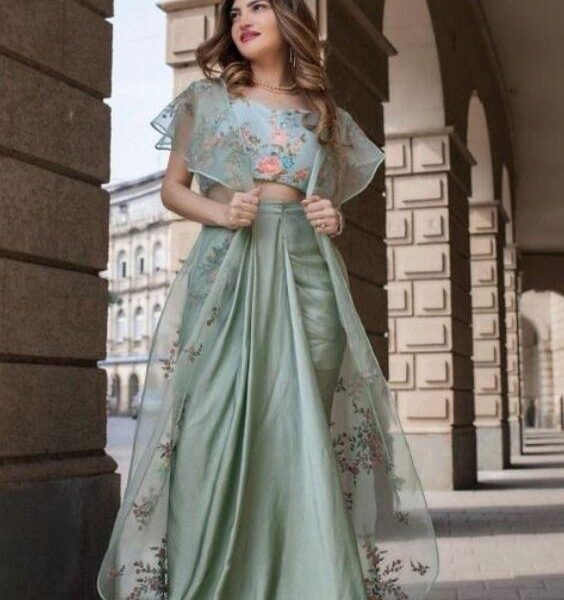Exploring the Elegance of Indian Dresses for Women
In a world where fashion knows no bounds, Indian dresses stand as a vibrant testament to cultural heritage and artistry. From the intricate motifs of a traditional saree to the contemporary flair of a flowy anarkali, each garment tells a story steeped in history, tradition, and identity. As we embark on this journey through the diverse realm of women’s Indian wear, we will explore the rich tapestry of fabrics, styles, and traditions that make these garments not only a fashion statement but also a celebration of femininity and grace. Join us as we unravel the threads of design and heritage that bind these exquisite pieces to the heart of Indian culture, and discover how age-old craftsmanship marries modern elegance to create timeless attire for women of all ages.
Table of Contents
- The Evolution of Traditional Indian Dresses for Women
- Embracing Diversity: Regional Styles and Their Significance
- Modern Twists: Contemporary Fabrics and Designs in Indian Wear
- Choosing the Right Dress: Tips for Every Occasion and Body Type
- Q&A
- In Conclusion
The Evolution of Traditional Indian Dresses for Women
The rich tapestry of Indian fashion has witnessed a remarkable transformation over the years, reflecting the diverse cultural influences and modern sensibilities of contemporary society. Traditional garments, once defined by intricate handwork and vibrant colors, have evolved into versatile pieces that cater to the dynamic lifestyles of today’s women. Classic attire such as the saree has reinvented itself with a plethora of draping styles and fabric choices, thus appealing to the younger generation. Alongside, the salwar kameez has been modernized with cropped tops and palazzo pants, making it a favorite for both casual and formal occasions.
Furthermore, the emergence of sustainable fashion and eco-friendly materials has reshaped how traditional dresses are perceived. Fashion designers are increasingly embracing heritage textiles and traditional craftsmanship, blending them with contemporary designs. This fusion creates a unique wardrobe that is not only fashionable but also respectful of cultural roots. Key trends in this evolution include:
- Fusion Attire: Merging Indian and Western styles to create innovative outfits.
- Embellished Fabrics: Use of sequins and beads to add modern flair to traditional garments.
- Comfort-Centric Designs: Focus on breathable fabrics and relaxed silhouettes.
| Traditional Dress | Modern Twist |
|---|---|
| Saree | Ready-to-Wear options with structured drapes |
| Lehenga | Short choli and jacket style blouses |
| Anarkali | Asymmetrical cuts and layered looks |
Embracing Diversity: Regional Styles and Their Significance
India’s rich tapestry of cultures and traditions is beautifully reflected in its women’s dresses, which vary significantly from region to region. Each style is not merely an expression of aesthetics but is steeped in the history and traditions of its origin. For instance, the Kanjeevaram sarees of Tamil Nadu, renowned for their intricate weaving and vibrant colors, are often worn during weddings and auspicious occasions, symbolizing prosperity and elegance. In stark contrast, the phiran, a woolen gown popular in Kashmir, serves as a practical yet stylish garment that offers warmth during the harsh winters, encapsulating the regional responses to both climate and culture.
The significance of these regional styles extends beyond mere fashion; they are vital in preserving heritage and promoting cultural identity. Visitors to India often find themselves captivated by the stunning craftsmanship that goes into every garment. Consider the following notable styles:
| Style | Region | Characteristic |
|---|---|---|
| Saree | Various | Graceful draping; versatile fabrics |
| Lehenga | North India | Flared skirt with embellishments; festive wear |
| Anarkali Suit | North India | Long flared silhouette; elegant for formal occasions |
| Ghagra Choli | Rajasthan | Colorful, intricate designs; traditional dance wear |
| Salwar Kameez | Punjab | Comfortable, versatile; suitable for daily wear |
As each garment tells its own story, it becomes essential to celebrate and embrace these diverse styles that enrich India’s cultural landscape. From the delicate embroideries of Rajasthan to the bold prints of Gujarat, women’s clothing serves as a vibrant gallery of regional artistry, encouraging a deeper appreciation for the uniqueness found within India’s multifaceted identity.
Modern Twists: Contemporary Fabrics and Designs in Indian Wear
In the realm of Indian fashion, the fusion of tradition and modernity has given rise to an exciting array of contemporary fabrics and designs. Designers are not only embracing traditional textiles like silk and cotton but are also introducing innovative materials such as *georgette*, *chiffon*, and *organza*. These fabrics offer a lighter, more breathable feel, perfect for today’s fast-paced lifestyle. The vibrant hues and intricate patterns that characterize Indian wear are being reimagined through digital printing technology, allowing for bolder designs that appeal to a younger audience. Notable trends include:
- Asymmetric hemlines: A playful twist on the classic silhouette, bringing a fresh perspective to traditional silhouettes.
- Layering: Combining kurtas, capes, and palazzos for a look that is both sophisticated and dynamic.
- Minimalistic embellishments: Subtle work and detailing that add a touch of elegance without overwhelming the ensemble.
Color plays a pivotal role in contemporary Indian wear, with designers favoring unexpected palettes. Shades like *pastel mint*, *dusty rose*, and *coral* are making waves, offering a soft contrast to the bold and vibrant colors traditionally associated with Indian attire. Patterns like abstract motifs and geometric designs are now often seen in lehengas and sarees, making them suitable for various occasions—from casual gatherings to formal events. Here’s a quick glance at some popular modern fabrics:
| Fabric | Characteristics | Best For |
|---|---|---|
| Georgette | Lightweight, flowy | Sarees, dresses |
| Chiffon | Sheer, soft | Capes, dupattas |
| Organza | Crisp, structured | Lehengas, blouses |
Choosing the Right Dress: Tips for Every Occasion and Body Type
When selecting an Indian dress, it’s essential to consider both the occasion and your unique body type. A fluttering anarkali is perfect for festive events and weddings, flattering almost all figure types with its flowing silhouette. If you’re looking for something more casual, a kurti paired with leggings can be both comfortable and chic for everyday wear, accommodating various body shapes. For a formal gathering, a well-fitted lehenga choli can accentuate your curves and provide a touch of elegance that is sure to impress.
Understanding the fabric and design is equally important. Soft, flowing materials such as georgette and chiffon are ideal for summers, while heavier silk options offer warmth and richness in the winter months. Consider these tips when browsing for your next outfit:
- Body Shape: A-line silhouettes can be universally flattering, while empire waists suit pear-shaped bodies.
- Occasion: For casual settings, choose lighter fabrics and vibrant colors, while formal events call for deeper tones and heavier materials.
- Accessories: Match your dress with suitable jewelry and footwear to enhance the overall look.
| Body Type | Recommended Dress | Key Features |
|---|---|---|
| Hourglass | Lehenga Choli | Accentuates curves |
| Pear | Anarkali | Disguises hips |
| Apple | Empire Line Kurti | Enhances bust, draws attention upwards |
| Rectangle | Flared Anarkali | Adds volume and shape |
Q&A
Q&A: Exploring the Beauty of Indian Women’s Dresses
Q1: What are some traditional Indian dresses for women?
A1: Traditional Indian dresses for women are diverse and rich in culture, each representing different regions and communities. Some iconic styles include the saree, a long piece of cloth draped elegantly around the body; the salwar kameez, consisting of a tunic paired with loose trousers; and the lehenga choli, a long skirt paired with a fitted blouse. Additionally, regional garments like the phiran from Kashmir and the ghagra from Rajasthan showcase the rich textile heritage of India.
Q2: How do Indian dresses vary across different regions of the country?
A2: Indian dresses vary significantly across different regions, reflecting the local culture, climate, and traditions. For example, in the southern states, women often wear sarees made from light, breathable fabrics suited to the warm climate, while in the northern regions, heavier fabrics and intricate embroidery styles are common. In the east, the traditional sari draping styles often feature vibrant colors and patterns, whereas in the west, the ghagra choli is popular during festivals and weddings. Each region has its unique textiles, embroideries, and draping methods, contributing to the country’s rich tapestry of women’s fashion.
Q3: What are contemporary trends in Indian women’s dresses?
A3: Contemporary trends in Indian women’s dresses blend traditional styles with modern aesthetics. Designers are increasingly experimenting with fusion wear, such as saree gowns, which combine the elegance of a saree with the ease of a gown. Other popular trends include the use of sustainable fabrics and handloom textiles, as well as innovative draping styles and bold color palettes. Western silhouettes with Indian fabrics, like crop tops paired with long skirts or dhoti pants, are also gaining popularity, offering a fresh perspective on traditional attire.
Q4: How can women choose the right Indian dress for an occasion?
A4: Choosing the right Indian dress for an occasion involves considering the event’s formality, personal style, and comfort. For wedding celebrations, richly embroidered sarees or lehengas are perfect choices, while a casual get-together may call for a comfy salwar kameez or tunic paired with palazzo pants. Additionally, it’s essential to factor in the weather—lighter fabrics for summer events and heavier ones for winter occasions. Women should also consider the cultural significance of the attire and choose colors and styles that resonate with their personal identity.
Q5: What role do accessories play in complementing Indian dresses?
A5: Accessories play a vital role in enhancing Indian dresses, adding a touch of elegance and individuality. Statement jewelry, such as jhumkas (traditional earrings) or choker necklaces, can transform an outfit. Dupattas (scarves) are also commonly styled with salwar kameez and sarees, adding layers and depth to the look. Belts can accentuate the waistline of lehengas or sarees, while colorful bangles and potli bags further bring out the dress’s vibrancy. Ultimately, accessories allow for personal expression and help create a cohesive aesthetic that celebrates the beautiful nuances of Indian attire.
Q6: Where can one find authentic Indian dresses?
A6: Authentic Indian dresses can be found in various places, from vibrant local markets to high-end boutiques. Major cities often have dedicated areas for traditional clothing, offering a wide selection of sarees, salwar kameez, and lehengas. Online platforms and websites specializing in Indian fashion have emerged, making it easier to browse and shop from the comfort of home. Additionally, participating in cultural fairs and exhibitions can provide opportunities to discover handcrafted garments made by local artisans, ensuring that you support traditional craftsmanship while selecting unique pieces for your wardrobe.
—
Feel free to customize any questions or answers further to suit your preferences!
In Conclusion
the vibrant tapestry of Indian dresses for women reflects not just the rich cultural heritage of the country but also the evolving nature of fashion itself. From the graceful drapes of sarees to the elegant silhouettes of lehengas and the contemporary flair of fusion wear, each garment tells a story steeped in tradition while embracing modernity. As Indian women continue to redefine these styles in their own unique ways, the diversity and versatility of these dresses serve as a canvas for self-expression and celebration. Whether worn at a festive occasion or in everyday life, Indian dresses transcend mere clothing; they embody a connection to history, culture, and the spirit of femininity. As we look to the future, it’s clear that these garments will continue to inspire, unite, and empower women across the globe, weaving new narratives into the rich fabric of Indian fashion.



